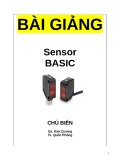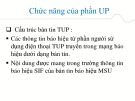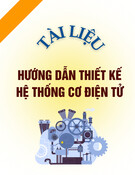Nguyễn Công Phương
Sensors and Analytical Devices
Some Basic Measurement Methods, Mass, Force, and Torque Measurement
Contents
A. Introduction B. Sensors Characteristics C. Some Basic Measurement Methods D. Measurement Systems
sites.google.com/site/ncpdhbkhn 2
Some Basic Measurement Methods
I. Sensor Technologies II. Temperature Measurement III. Pressure Measurement IV.Flow Measurement V. Level Measurement VI.Mass, Force, and Torque Measurement VII.Translational Motion, Vibration, and Shock
Measurement
VIII.Rotational Motion Transducers
sites.google.com/site/ncpdhbkhn 3
Mass, Force, and Torque Measurement
1. Introduction 2. Mass (Weight) Measurement 3. Force Measurement 4. Torque Measurement
sites.google.com/site/ncpdhbkhn 4
Introduction
• Mass, force, & torque are closely related
quantities.
• Mass: the quantity of matter that a body
contains.
• Force:
F = ma
• Weight:
P = mg • Torque: can be regarded as a rotational force.
sites.google.com/site/ncpdhbkhn 5
Mass (Weight) Measurement
• The mass of a body is always quantified in terms of a measurement of the weight of the body. • Weight: the downward force exerted by the body
when it is subject to gravity.
• Three methods used to measure this force:
– Load cell: measure the downward force exerted by a
mass subject to gravity.
– Spring balance: also measure the downward force
exerted by a mass subject to gravity.
– Mass balance: compare the gravitational force on the mass being measured with the gravitational force on a standard mass.
sites.google.com/site/ncpdhbkhn 6
Mass, Force, and Torque Measurement
1. Introduction 2. Mass (Weight) Measurement
a) Electronic Load Cell (Electronic Balance) b) Pneumatic & Hydraulic Load Cells c) Mass Balance (Weighing) Instruments d) Spring Balance 3. Force Measurement 4. Torque Measurement
sites.google.com/site/ncpdhbkhn 7
Electronic Load Cell (1)
• A.k.a. electronic balance. • Now the preferred type of load cell in
most application.
• Within an electronic load cell:
– The gravitational force on the body being measured is applied to an elastic element.
– This element deflects according to the
magnitude of the body mass
– Mass measurement is then translated into
a displacement measurement task.
http://www.bme.uconn.edu/sendes/ Fall04/Team2/FInal%20report.htm
http://www.hbm.com/en/menu/tips- tricks/load-measurement/how-does-a- bending-beam-load-cell-work/
sites.google.com/site/ncpdhbkhn 8
Electronic Load Cell (2)
http://www.houseofloadcell.com/
http://www.hbm.com/en/menu/tips- tricks/load-measurement/how-does-a- bending-beam-load-cell-work/
sites.google.com/site/ncpdhbkhn 9
Electronic Load Cell (3)
• The elastic element design is to:
– Obtain a linear output relationship between the applied force & the
measured deflection, and
– To make the instrument insensitive to forces that are not applied
directly along the sensing axis.
• Load cells:
– Compression type: the measured mass is placed on top of a platform
resting on the load cell, which compresses the cell.
– Tension type: the mass is hung from the load cell, putting the cell into
tension.
http://www.hbm.com/en/menu/tips- tricks/load-measurement/how-does-a- bending-beam-load-cell-work/
sites.google.com/site/ncpdhbkhn 10
Electronic Load Cell (4)
• Various types of displacement transducers are used to
measure the deflection of the elastic elements: strain gauge & piezoelectric device.
• The strain gauge:
– Used most commonly – Inaccuracy: less than ±0.05% – Range:
• Small masses: 0.1 – 5 kg • Other: 10 – 3000 tonne. • The piezoelectric device: – Range: 0 – 1000 tonne. – Physically small – Can measure dynamically changing forces only. – Inaccuracy: ±1%. – Inexpensive.
sites.google.com/site/ncpdhbkhn 11
Electronic Load Cell (5)
• Advantages:
– Relatively low cost – Wide measurement range – Tolerance of dusty & corrosive environments – Tolerance of shock loading – Easy installation.
• Disadvantage: permanent deformation that an elastic element undergoes after it has been under load for a period of time.
sites.google.com/site/ncpdhbkhn 12
Mass, Force, and Torque Measurement
1. Introduction 2. Mass (Weight) Measurement
a) Electronic Load Cell (Electronic Balance) b) Pneumatic & Hydraulic Load Cells c) Mass Balance (Weighing) Instruments d) Spring Balance 3. Force Measurement 4. Torque Measurement
sites.google.com/site/ncpdhbkhn 13
Pneumatic Load Cell
• Translate mass measurement into a pressure measurement.
• Less common than the electronic load cell.
• The output pressure measured in the cell is approximately proportional to the magnitude of the gravitational force on the applied mass.
• Requires a flow of air at its
input of around 0.25 m3/h at a pressure of 4 ar.
PRESSURE METER
• Range:
– Small masses: 25 kg – Other: 25 tonne Inaccuracy: ±0.5%.
•
http://www.buildingcontrolworkbench.com/ BCWInfo/GrayBook/Gpneubsc.htm
sites.google.com/site/ncpdhbkhn 14
Hydraulic Load Cell
• Translate mass measurement into a pressure measurement.
• Less common than the electronic load cell.
• Hydraulic fluid (e.g., oil)
contained within an enclosed chamber.
• Designed for measuring much larger masses than pneumatic cell.
• Range: 500 tonne – 50,000
tonn.
• Inacurracy: ±0.05%.
http://www.npl.co.uk/science-+-technology/mass,- force,-pressure/force/hydraulic-load-cell
sites.google.com/site/ncpdhbkhn 15
Mass, Force, and Torque Measurement
1. Introduction 2. Mass (Weight) Measurement
a) Electronic Load Cell (Electronic Balance) b) Pneumatic & Hydraulic Load Cells c) Mass Balance (Weighing) Instruments i. Beam Balance (Equal Arm Balance) ii. Weigh Beam iii. Pendulum Scale iv. Electromagnetic Balance
d) Spring Balance 3. Force Measurement 4. Torque Measurement
sites.google.com/site/ncpdhbkhn 16
Beam Balance • Standard masses are added to a pan on one side of a pivoted beam until the magnitude of the gravity force on them balances the magnitude of the gravitational force on the unknown mass acting at the other pan.
• This equilibrium position is indicated by a pointer that moves
against a calibrated scale. • Range: less than 0.01 gram. Inaccuracy: ±0.002%. • • Disadvantages:
– Lack of ruggedness: continous use & shock loading will lead to deterioration in accuracy & resolution.
– A relatively long time to make
each measurement
• Used as a calibration standard &
not used in day-to-day production environments.
http://visual.merriam-webster.com/science/measuring- devices/measure-weight/robervals-balance.php
sites.google.com/site/ncpdhbkhn 17
Weigh Beam
• Similar principles to the beam balance, but much
more rugged.
• Range: up to 50 tonne.
http://emmaandmelissa.blo gspot.com/2013/01/unit-2- 3-project.html
sites.google.com/site/ncpdhbkhn 18
Mass, Force, and Torque Measurement
1. Introduction 2. Mass (Weight) Measurement
a) Electronic Load Cell (Electronic Balance) b) Pneumatic & Hydraulic Load Cells c) Mass Balance (Weighing) Instruments i. Beam Balance (Equal Arm Balance) ii. Weigh Beam iii. Pendulum Scale iv. Electromagnetic Balance
d) Spring Balance 3. Force Measurement 4. Torque Measurement
sites.google.com/site/ncpdhbkhn 19
Pendulum Scale
http://www.wedo.de/index.php?id=10778&lang=3
sites.google.com/site/ncpdhbkhn 20
Electromagnetic Balance
The weighing beam starts to incline when the weight is applied on scale pan.
The photo sensor detects the minute incline immediately.
This change of current is directly proportional to the change of weight, this current change can be used as weight signal.
The controller increases the current to electromagnetic coil in order to balance the weighing beam based on the detection result of photo sensor.
http://www.ishida.com/technologies/force_balance/html.html
sites.google.com/site/ncpdhbkhn 21
Mass, Force, and Torque Measurement
1. Introduction 2. Mass (Weight) Measurement
a) Electronic Load Cell (Electronic Balance) b) Pneumatic & Hydraulic Load Cells c) Mass Balance (Weighing) Instruments d) Spring Balance 3. Force Measurement 4. Torque Measurement
sites.google.com/site/ncpdhbkhn 22
Spring Balance
• Simple & inexpensive. • The characteristics of the
spring are very susceptible to environmental changes measurement accuracy is usually relatively poor. • Range: 0.5kg – 10 tonne.
http://kids.britannica.com/elementary/ art-7544/Spring-balance
sites.google.com/site/ncpdhbkhn 23
Mass, Force, and Torque Measurement
1. Introduction 2. Mass (Weight) Measurement 3. Force Measurement
a) Use of Accelerometers b) Vibrating Wire Sensor c) Use of Load Cells 4. Torque Measurement
sites.google.com/site/ncpdhbkhn 24
Use of Accelerometers
• F = ma • Can be carried out using any type of
accelerometers.
• Is of very limited practical value because, in
most cases, forces act on some body that is not free to accelerate.
• Can be used in measuring some transient
forces & also for calibrating forces produced by thrust motors in space vehicles.
sites.google.com/site/ncpdhbkhn 25
Vibrating Wire Sensor
Resonant frequency = f(applied force)
sites.google.com/site/ncpdhbkhn 26
Use of Load Cells
http://www.hbm.com/en/menu/tips- tricks/load-measurement/how-does-a- bending-beam-load-cell-work/
sites.google.com/site/ncpdhbkhn 27
Mass, Force, and Torque Measurement
1. Introduction 2. Mass (Weight) Measurement 3. Force Measurement 4. Torque Measurement
a) Measurement of Induced Strain b) Optical Torque Measurement
sites.google.com/site/ncpdhbkhn 28
Measurement of Induced Strain
•
•
• Has been the most common method used for torque measurement in recent years. It is very important that positioning of the strain gauges on the shaft is precise the instrument is relatively expensive. Ideal for measuring the stalled torque in a shaft before rotation begins.
• Problem: in the case of rotating
shafts, a suitable method then has to be found for making the electrical connections to the strain gauges (slip rings & brushes) more expensive.
http://www.appmeas.co.uk/images/ torque-shaft-shear-stresses.gif
sites.google.com/site/ncpdhbkhn 29
Optical Torque Measurement
• Becomese available recently with the development of laser diodes & fiber-optic light transmission systems.
• 2 black-&-white striped wheel are mounted at either end of rotating shaft & are in alignment when no torque is applied to the shaft. • Light from a laser diode light
source is directed by a pair of fiber- optic cables onto the wheels. • No torque: the 2 pulse trains of reflected light are in phase. • Torque: not in phase phase
difference torque.
• Advantages: – Low cost – Small physical size.
sites.google.com/site/ncpdhbkhn 30






















![Bài giảng Kỹ thuật robot [Mới nhất]](https://cdn.tailieu.vn/images/document/thumbnail/2025/20250715/vijiraiya/135x160/366_bai-giang-ky-thuat-robot.jpg)
![Câu hỏi ôn tập Cơ sở xử lý ảnh số [năm] chuẩn nhất](https://cdn.tailieu.vn/images/document/thumbnail/2025/20250710/kimphuong1001/135x160/84701752136985.jpg)

![Câu hỏi ôn tập Robot công nghiệp [năm hiện tại]](https://cdn.tailieu.vn/images/document/thumbnail/2025/20250702/kimphuong555/135x160/7711751422232.jpg)
